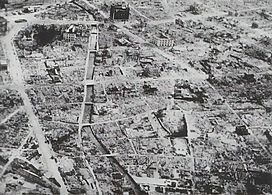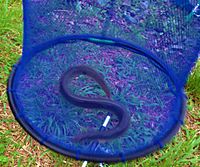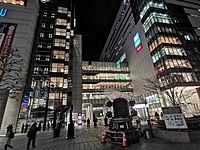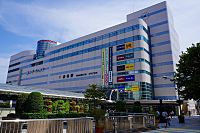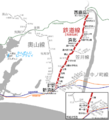Hamamatsu facts for kids
Quick facts for kids
Hamamatsu
浜松市
|
|||||||||||||
|---|---|---|---|---|---|---|---|---|---|---|---|---|---|
|
|||||||||||||
|
|||||||||||||
| Nickname(s):
"City of Music"
|
|||||||||||||

Location of Hamamatsu in Shizuoka Prefecture
|
|||||||||||||
| Country | Japan | ||||||||||||
| Region | Chūbu (Tōkai) | ||||||||||||
| Prefecture | Shizuoka | ||||||||||||
| Area | |||||||||||||
| • Total | 1,558.06 km2 (601.57 sq mi) | ||||||||||||
| Population
(September 1, 2023)
|
|||||||||||||
| • Total | 780,128 | ||||||||||||
| • Density | 500.7047/km2 (1,296.819/sq mi) | ||||||||||||
| Time zone | UTC+9 (Japan Standard Time) | ||||||||||||
| Phone number | 53-457-2111 | ||||||||||||
| Address | 103-2 Motoshiro-chō, Chūō-ku, Hamamatsu-shi, Shizuoka-ken 430-8652 | ||||||||||||
| Climate | Cfa | ||||||||||||
|
|||||||||||||
Hamamatsu (浜松市, Hamamatsu-shi) is a large city in western Shizuoka Prefecture, Japan. As of September 2023, about 780,128 people lived there in 340,591 homes. This makes it the biggest city in Shizuoka Prefecture.
Contents
About Hamamatsu City
Hamamatsu is a city that cares about its people's health. It is part of the World Health Organization's Alliance for Healthy Cities. This group works to make cities healthy places for everyone.
History of Hamamatsu
Ancient Beginnings
People have lived in the Hamamatsu area for a very long time. We know this because of old remains found here. These include shell mounds and ancient tombs from the Jōmon period and Kofun period.
Middle Ages and Castles
During the Nara period, Hamamatsu became the main city of Tōtōmi Province. Later, in the Sengoku period, Hamamatsu Castle was home to Tokugawa Ieyasu. He later became a very important leader called a shōgun.
Edo Period Growth
Hamamatsu grew a lot during the Edo period. It was a busy castle town and a post town. This meant it was an important stop on the Tōkaidō highway. This road connected the big cities of Edo (now Tokyo) and Kyoto.
Modern Times and Changes
After the Meiji Restoration in 1868, Hamamatsu became its own prefecture for a short time. Then, in 1876, it joined Shizuoka Prefecture. Hamamatsu Station opened in 1889, making travel easier.
In 1911, Hamamatsu officially became a city. Later, in 1945, during World War II, Hamamatsu was heavily damaged by air raids. The city was rebuilt after the war. In 2005, many nearby towns and villages joined Hamamatsu, making it much larger. In 2007, it became a "city designated by government ordinance." This means it has more power to make its own decisions.
City Views
-
CBD of Hamamatsu
Geography and Climate
Hamamatsu is about 260 kilometers (160 miles) southwest of Tokyo. The city has flat areas in the south and mountains in the north. It is near Lake Hamana to the west and the Tenryū River to the east. The Pacific Ocean is to the south.
Weather in Hamamatsu
Southern Hamamatsu has a humid subtropical climate. This means cool or mild winters with little snow. However, it can be very windy in winter due to a dry wind called Enshū no Karakaze. Northern Hamamatsu has harsher weather. Summers are hot, often reaching over 35 degrees Celsius (95 degrees Fahrenheit). It also snows in winter in the northern parts.
| Climate data for Hamamatsu (1991−2020 normals, extremes 1882−present) | |||||||||||||
|---|---|---|---|---|---|---|---|---|---|---|---|---|---|
| Month | Jan | Feb | Mar | Apr | May | Jun | Jul | Aug | Sep | Oct | Nov | Dec | Year |
| Record high °C (°F) | 20.7 (69.3) |
23.6 (74.5) |
24.9 (76.8) |
28.1 (82.6) |
31.8 (89.2) |
36.7 (98.1) |
39.2 (102.6) |
41.1 (106.0) |
36.6 (97.9) |
32.1 (89.8) |
27.8 (82.0) |
23.2 (73.8) |
41.1 (106.0) |
| Mean daily maximum °C (°F) | 10.6 (51.1) |
11.5 (52.7) |
15.0 (59.0) |
19.6 (67.3) |
23.7 (74.7) |
26.6 (79.9) |
30.3 (86.5) |
31.8 (89.2) |
28.8 (83.8) |
23.6 (74.5) |
18.6 (65.5) |
13.2 (55.8) |
21.1 (70.0) |
| Daily mean °C (°F) | 6.3 (43.3) |
6.8 (44.2) |
10.3 (50.5) |
15.0 (59.0) |
19.3 (66.7) |
22.6 (72.7) |
26.3 (79.3) |
27.8 (82.0) |
24.9 (76.8) |
19.6 (67.3) |
14.2 (57.6) |
8.8 (47.8) |
16.8 (62.2) |
| Mean daily minimum °C (°F) | 2.4 (36.3) |
2.7 (36.9) |
5.7 (42.3) |
10.7 (51.3) |
15.3 (59.5) |
19.4 (66.9) |
23.4 (74.1) |
24.7 (76.5) |
21.5 (70.7) |
16.2 (61.2) |
10.4 (50.7) |
4.8 (40.6) |
13.1 (55.6) |
| Record low °C (°F) | −6.0 (21.2) |
−5.5 (22.1) |
−3.3 (26.1) |
0.0 (32.0) |
4.7 (40.5) |
10.4 (50.7) |
15.3 (59.5) |
16.8 (62.2) |
12.4 (54.3) |
3.8 (38.8) |
0.1 (32.2) |
−4.2 (24.4) |
−6.0 (21.2) |
| Average precipitation mm (inches) | 59.2 (2.33) |
76.8 (3.02) |
147.1 (5.79) |
179.2 (7.06) |
191.9 (7.56) |
224.5 (8.84) |
209.3 (8.24) |
126.8 (4.99) |
246.1 (9.69) |
207.1 (8.15) |
112.6 (4.43) |
62.7 (2.47) |
1,843.2 (72.57) |
| Average snowfall cm (inches) | 0 (0) |
0 (0) |
0 (0) |
0 (0) |
0 (0) |
0 (0) |
0 (0) |
0 (0) |
0 (0) |
0 (0) |
0 (0) |
0 (0) |
0 (0) |
| Average precipitation days (≥ 0.5 mm) | 5.9 | 6.5 | 9.8 | 10.4 | 10.8 | 13.1 | 11.9 | 8.4 | 11.9 | 10.9 | 7.5 | 6.3 | 113.4 |
| Average relative humidity (%) | 57 | 56 | 59 | 65 | 70 | 78 | 77 | 76 | 74 | 72 | 64 | 61 | 67 |
| Mean monthly sunshine hours | 206.6 | 187.8 | 201.9 | 199.7 | 205.1 | 148.1 | 176.3 | 211.4 | 166.7 | 162.6 | 171.8 | 200.1 | 2,237.9 |
| Source: Japan Meteorological Agency | |||||||||||||
| Climate data for Sakuma, Hamamatsu (1991−2020 normals, extremes 1978−present) | |||||||||||||
|---|---|---|---|---|---|---|---|---|---|---|---|---|---|
| Month | Jan | Feb | Mar | Apr | May | Jun | Jul | Aug | Sep | Oct | Nov | Dec | Year |
| Record high °C (°F) | 17.8 (64.0) |
23.0 (73.4) |
26.3 (79.3) |
31.9 (89.4) |
34.1 (93.4) |
36.9 (98.4) |
40.2 (104.4) |
39.6 (103.3) |
37.3 (99.1) |
33.6 (92.5) |
25.7 (78.3) |
23.0 (73.4) |
40.2 (104.4) |
| Mean daily maximum °C (°F) | 9.7 (49.5) |
11.1 (52.0) |
14.9 (58.8) |
20.2 (68.4) |
24.8 (76.6) |
27.5 (81.5) |
31.3 (88.3) |
32.9 (91.2) |
28.9 (84.0) |
23.2 (73.8) |
17.3 (63.1) |
11.8 (53.2) |
21.1 (70.0) |
| Daily mean °C (°F) | 3.1 (37.6) |
4.3 (39.7) |
7.9 (46.2) |
13.1 (55.6) |
17.9 (64.2) |
21.5 (70.7) |
25.2 (77.4) |
26.3 (79.3) |
22.8 (73.0) |
16.9 (62.4) |
10.6 (51.1) |
5.2 (41.4) |
14.6 (58.2) |
| Mean daily minimum °C (°F) | −1.5 (29.3) |
−0.8 (30.6) |
2.3 (36.1) |
7.2 (45.0) |
12.4 (54.3) |
17.3 (63.1) |
21.3 (70.3) |
22.3 (72.1) |
19.0 (66.2) |
12.8 (55.0) |
6.2 (43.2) |
0.7 (33.3) |
9.9 (49.9) |
| Record low °C (°F) | −7.1 (19.2) |
−8.1 (17.4) |
−4.8 (23.4) |
−2.6 (27.3) |
3.3 (37.9) |
9.0 (48.2) |
15.3 (59.5) |
16.4 (61.5) |
9.8 (49.6) |
2.4 (36.3) |
−1.9 (28.6) |
−6.3 (20.7) |
−8.1 (17.4) |
| Average precipitation mm (inches) | 71.0 (2.80) |
97.6 (3.84) |
184.1 (7.25) |
193.5 (7.62) |
192.0 (7.56) |
265.6 (10.46) |
339.1 (13.35) |
225.9 (8.89) |
320.9 (12.63) |
223.5 (8.80) |
120.8 (4.76) |
78.1 (3.07) |
2,344 (92.28) |
| Average precipitation days (≥ 1.0 mm) | 6.5 | 6.7 | 9.9 | 10.2 | 10.7 | 13.0 | 13.6 | 11.0 | 11.7 | 10.6 | 7.2 | 6.8 | 117.9 |
| Mean monthly sunshine hours | 152.9 | 167.1 | 187.4 | 194.0 | 194.0 | 138.0 | 156.4 | 187.4 | 148.2 | 163.1 | 151.7 | 142.4 | 1,982.5 |
| Source: Japan Meteorological Agency | |||||||||||||
Nearby Cities and Towns
Hamamatsu is surrounded by several other cities and towns.
- Toyohashi
- Shinshiro
- Tōei
- Toyone
- Iida
- Tenryū
Population and People
Hamamatsu's population has grown steadily over the last 70 years.
| Historical population | ||
|---|---|---|
| Year | Pop. | ±% |
| 1940 | 434,253 | — |
| 1950 | 494,296 | +13.8% |
| 1960 | 568,214 | +15.0% |
| 1970 | 631,284 | +11.1% |
| 1980 | 698,982 | +10.7% |
| 1990 | 751,509 | +7.5% |
| 2000 | 786,306 | +4.6% |
| 2010 | 800,912 | +1.9% |
| 2020 | 790,718 | −1.3% |
People from Other Countries
Hamamatsu has many people from other countries, especially Brazilians. This started after a law change in 1990 allowed them to work in Japan. Many foreigners work in factories for companies like Honda, Suzuki, and Yamaha. You can see a lot of Portuguese signs in the city. There are even Brazilian schools and businesses.
Economy and Industry
Hamamatsu is known as an industrial city. It is especially famous for making musical instruments and motorcycles. The city also used to be known for its fabric industry. In 2010, the Hamamatsu area had a total economic output of about 54.3 billion US dollars.
Companies in Hamamatsu
Many well-known companies have their main offices or were started in Hamamatsu.
- Enkei Corporation
- Hamamatsu Photonics K.K.
- Kawai Musical Instruments Mfg.
- Roland Corporation
- Suzuki Motor Co.
- Tōkai Gakki (also known as Tokai Guitars Company Ltd.)
- Yamaha Corporation
- Honda Motor Co. (founded here)
Transportation and Travel
Airports
Hamamatsu does not have its own civilian airport. The closest one is Shizuoka Airport, about 43 kilometers (27 miles) away. Chūbu Centrair International Airport in Aichi Prefecture is also nearby, about 87 kilometers (54 miles) west of the city.
Train Travel
Hamamatsu is a major stop for high-speed trains.
- Tōkaidō Shinkansen: This high-speed train line stops at Hamamatsu Station.
- The JR Central Hamamatsu workshop is a place where these high-speed trains are maintained.
There are also regular train lines that connect Hamamatsu to other areas.
- Tōkaidō Main Line: Connects many cities along the coast.
- Iida Line: Runs through more mountainous areas.
- Enshū Railway Line: A local train line within Hamamatsu.
- Tenryū Hamanako Railroad
- Tenryū Hamanako Line: Another local line, popular for sightseeing around Lake Hamana.
Roads
Hamamatsu has several important roads for cars and trucks.
Expressways
National Highways
 National Route 1
National Route 1 National Route 42
National Route 42 National Route 150
National Route 150 National Route 152
National Route 152 National Route 257
National Route 257 National Route 301
National Route 301 National Route 362
National Route 362 National Route 473
National Route 473
Education and Schools
Colleges and Universities
Hamamatsu has several universities and colleges where students can continue their studies after high school.
- Hamamatsu Gakuin University
- Hamamatsu University
- Hamamatsu University School of Medicine
- Seirei Christopher University
- Shizuoka University (with engineering and informatics programs)
- Shizuoka University of Art and Culture
- Seisa University, Hamamatsu campus
- Tokoha University, Hamamatsu campus
Local Schools
The city runs many elementary and junior high schools. There are also several senior high schools.
- Shizuoka Prefectural Hamamatsu North High School
- Shizuoka Prefectural Hamamatsu Nishi Senior and Junior High Schools
- Shizuoka Prefectural Hamamatsu East High School
- Shizuoka Prefectural Hamamatsu South High School
- Shizuoka Prefectural Kiga High School
- Shizuoka Prefectural Kohoku High School
- Shizuoka Prefectural Mikkabi High School
- Hamamatsu Municipal Senior High School
Learning for Everyone
Hamamatsu has many students from other countries. The city works to help these students learn and feel at home. There are special teachers and helpers who speak different languages, like Portuguese, to assist students. Some international schools also teach in other languages, such as Brazilian schools like Escola Brasil. Volunteers and non-profit groups also offer Japanese language classes for foreign children.
Fun Places to Visit
- Act City Tower Observatory: This is the tallest building in Hamamatsu. It looks like a harmonica, which reminds people that Hamamatsu is known as the "City of Music." You can go to the 45th floor for amazing views of the city and the ocean.
- Chopin Monument: This is a copy of a famous statue of the composer Chopin. The original is in Warsaw, Poland, which is a sister city to Hamamatsu.
- Hamamatsu Castle: This castle was once the home of Tokugawa Ieyasu, a very important leader in Japanese history. You can explore the castle and a museum inside. There's also a beautiful park with a Japanese garden and a koi pond.
- Nakatajima Sand Dunes: These are some of the largest sand dunes in all of Japan. They are a unique natural sight.
- Hamamatsu Flower Park: A beautiful park filled with many different kinds of flowers.
- Hamamatsu Fruit Park: A park where you can see and learn about various fruits.
- Hamamatsu Municipal Zoo: A great place to see animals from around the world.
- Iinoya-gū shrine: An important historical shrine.
- Motoshirochō Tōshō-gū shrine: Another historic shrine in the city.
- Gosha Suwa Shrine: A shrine formed from two older shrines that were damaged in World War II.
Culture and Events
Festivals and Celebrations
Hamamatsu is famous for its many exciting festivals throughout the year.
Akiha Fire Festival
This festival takes place in December. Long ago, people believed that Mount Akiha could prevent fires. During the festival, people perform dances with bows, swords, and fire at the Akiha Shrine. There's also a firewalking ceremony at Akiha Temple.
Hamamatsu Kite Festival
This big festival, also called Hamamatsu Festival, happens every year from May 3 to May 5. It includes a Tako Gassen, or kite fight, where huge kites battle in the sky. The festival started about 430 years ago to celebrate the birth of a lord's first son. At night, beautiful palace-like floats called yatai are paraded through the streets with traditional music.
Hamakita Hiryu Festival
Held in June, this festival honors Ryujin, a god linked to the Tenryū River. It features kite flying and a "flying dragon fire festival" with water, sound, and flames.
Hamamatsu International Piano Competition
This important music competition takes place in November every three years. It brings talented young pianists from all over the world to Hamamatsu, celebrating the city's musical heritage. It is held at the Act City Concert Hall.
Inasa Puppet Festival
In November, this festival brings puppet masters from all over Japan. They perform about 30 different puppet plays, offering a fun day for both kids and adults.
Princess Road Festival
In April, this festival reenacts a procession of a princess and her group of over 100 people. They walk along the Toda River under the beautiful cherry blossoms. This road was known as a "princess road" in the Edo period.
Samba Festival
Hamamatsu also hosts its own lively Samba Festival, bringing the vibrant music and dance of Brazil to the city.
Sports Teams
Hamamatsu is home to several sports teams.
| Club | Sport | League | Venue | Established |
|---|---|---|---|---|
| Chunichi Dragons | Baseball | Ce.League | Vantelin Dome Nagoya, Hamamatsu Baseball Stadium | 1936 |
| San-en NeoPhoenix | Basketball | B.League | Toyohashi City General Gymnasium, Hamamatsu Arena | 1965 |
| Honda FC | Soccer | Japan Football League (JFL) | Honda Miyakoda Soccer Stadium | 1971 |
| Agleymina Hamamatsu | Futsal | F.League | Hamamatsu Arena | 1996 |
| Breath Hamamatsu | Volleyball | V.League | Hamamatsu Arena | 2012 |
Basketball
The SAN-EN NeoPhoenix is Hamamatsu's professional basketball team. They play in the B.League, which is Japan's top basketball league. The Hamamatsu Arena was also one of the places where the 2006 FIBA World Championship for basketball was held.
Volleyball
Hamamatsu was also one of the cities that hosted the 2010 Women's Volleyball World Championship.
Cities Around the World
Hamamatsu has special relationships with cities in other countries. These are called sister cities or friendship cities.
Sister Cities
Hamamatsu has a Music Culture Exchange Treaty with these cities:
| City | Country | State | Since |
|---|---|---|---|
| Porterville | California | February 16, 1981 | |
| Camas | Washington | September 29. 1981 | |
| Chehalis | Washington | October 22, 1990 | |
| Rochester | New York | October 12, 2006 |
Twinned Cities
Hamamatsu is twinned with:
| City | Country | State | Since |
|---|---|---|---|
| Warsaw | Masovian Voivodeship | February 22, 1990 | |
| Manaus | Amazonas | June 20, 2008 | |
| Taipei | Special municipality | July 31, 2013 | |
| Bologna | Emilia-Romagna | April 23, 2014 | |
| Bandung | West Java | December 19, 2014 |
Friendship Cities
| City | Country | State | Since |
|---|---|---|---|
| Shenyang | Liaoning | August 28, 2010 | |
| Hangzhou | Zhejiang | April 6, 2012 |
Famous People from Hamamatsu
- Hiroshi Amano, a scientist who won the Nobel Prize in Physics in 2014.
- Yuri Chinen, a J-pop singer.
- Soichiro Honda, the person who started the Honda Motor Company.
- Toshio Kakei, an actor.
- Kanako Momota, a J-pop singer and leader of the group Momoiro Clover Z.
- Jiro Ono, a very famous sushi chef.
- Michio Suzuki, the person who started Suzuki Motors.
- Kenjiro Takayanagi, an engineer who helped develop the television.
- Hiromi Uehara, a jazz composer and pianist.
- Tetsuya Wakuda, a Japanese-born Australian chef.
Images for kids
See also
 In Spanish: Hamamatsu (Shizuoka) para niños
In Spanish: Hamamatsu (Shizuoka) para niños

























